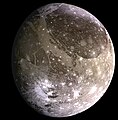Fișier:The Galilean satellites (the four largest moons of Jupiter).tif

Mărimea acestei previzualizări JPG a acestui fișier TIF: 800 × 262 pixeli. Alte rezoluții: 320 × 105 pixeli | 640 × 210 pixeli.
Mărește rezoluția imaginii (1.830 × 600 pixeli, mărime fișier: 1,51 MB, tip MIME: image/tiff)
Istoricul fișierului
Apăsați pe Data și ora pentru a vedea versiunea trimisă atunci.
| Data și ora | Miniatură | Dimensiuni | Utilizator | Comentariu | |
|---|---|---|---|---|---|
| actuală | 29 decembrie 2011 15:54 | 1.830x600 (1,51 MB) | Prof. Professorson | {{Information |Description=This composite includes the four largest moons of en:Jupiter which are known as the Galilean satellites. The Galilean satellites were first seen by the Italian astronomer en:Galileo Galilei in |
Utilizarea fișierului
Următoarele pagini conțin această imagine:
Utilizarea globală a fișierului
Următoarele alte proiecte wiki folosesc acest fișier:
- Utilizare la af.wikipedia.org
- Utilizare la als.wikipedia.org
- Utilizare la ar.wikipedia.org
- Utilizare la ast.wikipedia.org
- Utilizare la az.wikipedia.org
- Utilizare la ba.wikibooks.org
- Utilizare la be-tarask.wikipedia.org
- Utilizare la be.wikipedia.org
- Utilizare la bg.wikipedia.org
- Utilizare la bn.wikipedia.org
- Utilizare la bn.wikibooks.org
- Utilizare la bs.wikibooks.org
- Utilizare la ca.wikipedia.org
- Utilizare la cs.wikipedia.org
- Utilizare la en.wikipedia.org
- Utilizare la en.wikibooks.org
- Utilizare la es.wikipedia.org
- Utilizare la et.wikipedia.org
- Utilizare la eu.wikipedia.org
- Utilizare la fi.wikipedia.org
- Utilizare la fr.wikipedia.org
- Utilizare la gl.wikipedia.org
- Utilizare la he.wikipedia.org
- Utilizare la hi.wikipedia.org
- Utilizare la hu.wikipedia.org
- Utilizare la hy.wikipedia.org
- Utilizare la id.wikipedia.org
- Utilizare la it.wikipedia.org
- Utilizare la ja.wikipedia.org
- Utilizare la kk.wikipedia.org
- Utilizare la ko.wikipedia.org
Vizualizați utilizările globale ale acestui fișier.




